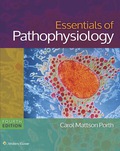
A.
To explain: The origin of pain stimuli in appendicitis and the associated neural pathway.
Introduction: Appendicitis refers to the medical condition characterized by the painful inflammation of the appendix leading to abdominal pain. The only way to treat this condition is the surgical removal of the appendix or appendicectomy.
A.
Explanation of Solution
The pain in appendicitis begins around the umbilicus (belly button), which may come and go. This pain then spreads to the lower right abdomen turning out severe and constant.
The mechanism for this acute pain in the abdominal region is as follows:
The injury to the appendix leads to the release of inflammatory mediators such as prostaglandins, serotonin, and acetylcholine that causes inflammation. This stimulates the activation of nociceptors or pain receptors through which pain impulses are transmitted to the dorsal horn of the spinal cord. As the pain due to appendicitis is fast and sharply discriminated, it follows the neospinothalamic tract, which means that pain impulses are transmitted from the spinal cord to the thalamus for the interpretation.
B.
To explain: The neural mechanisms involved in the spasm of the overlying abdominal muscles.
Introduction: During appendicitis, the cramping in the abdominal region due to the rigid expansion of overlying muscles is referred to as abdominal spasm.
B.
Explanation of Solution
Muscle spasm or guarding is a protective reflex rigidity. It acts as a protective mechanism as it minimizes the muscle movement and stabilizes the affected area. These spasms may result in mild, moderate, or severe pain in the lower region of the abdominal cavity.
C.
To explain: The significance of cool and moist skin along with the increased blood pressure, and heart rate during appendicitis.
Introduction: The blockage of the appendix often by feces or any foreign body may cause it to swell. This swelling is referred to as appendicitis, which may cause symptoms such as abdominal pain, loss of appetite, nausea, vomiting, severe cramps, and diarrhea.
C.
Explanation of Solution
Other than abdominal pain, loss of appetite, nausea, and severe cramps, appendicitis also show symptoms such as cool and moist skin, increased blood pressure, and heart rate. The blockage of the appendix leads to increased blood pressure, while its rupture may cause an increased heart rate. This cardiogenic shock causes cool and clammy skin.
Want to see more full solutions like this?
Chapter 35 Solutions
EBK ESSENTIALS OF PATHOPHYSIOLOGY
 Human Anatomy & Physiology (11th Edition)BiologyISBN:9780134580999Author:Elaine N. Marieb, Katja N. HoehnPublisher:PEARSON
Human Anatomy & Physiology (11th Edition)BiologyISBN:9780134580999Author:Elaine N. Marieb, Katja N. HoehnPublisher:PEARSON Biology 2eBiologyISBN:9781947172517Author:Matthew Douglas, Jung Choi, Mary Ann ClarkPublisher:OpenStax
Biology 2eBiologyISBN:9781947172517Author:Matthew Douglas, Jung Choi, Mary Ann ClarkPublisher:OpenStax Anatomy & PhysiologyBiologyISBN:9781259398629Author:McKinley, Michael P., O'loughlin, Valerie Dean, Bidle, Theresa StouterPublisher:Mcgraw Hill Education,
Anatomy & PhysiologyBiologyISBN:9781259398629Author:McKinley, Michael P., O'loughlin, Valerie Dean, Bidle, Theresa StouterPublisher:Mcgraw Hill Education, Molecular Biology of the Cell (Sixth Edition)BiologyISBN:9780815344322Author:Bruce Alberts, Alexander D. Johnson, Julian Lewis, David Morgan, Martin Raff, Keith Roberts, Peter WalterPublisher:W. W. Norton & Company
Molecular Biology of the Cell (Sixth Edition)BiologyISBN:9780815344322Author:Bruce Alberts, Alexander D. Johnson, Julian Lewis, David Morgan, Martin Raff, Keith Roberts, Peter WalterPublisher:W. W. Norton & Company Laboratory Manual For Human Anatomy & PhysiologyBiologyISBN:9781260159363Author:Martin, Terry R., Prentice-craver, CynthiaPublisher:McGraw-Hill Publishing Co.
Laboratory Manual For Human Anatomy & PhysiologyBiologyISBN:9781260159363Author:Martin, Terry R., Prentice-craver, CynthiaPublisher:McGraw-Hill Publishing Co. Inquiry Into Life (16th Edition)BiologyISBN:9781260231700Author:Sylvia S. Mader, Michael WindelspechtPublisher:McGraw Hill Education
Inquiry Into Life (16th Edition)BiologyISBN:9781260231700Author:Sylvia S. Mader, Michael WindelspechtPublisher:McGraw Hill Education





